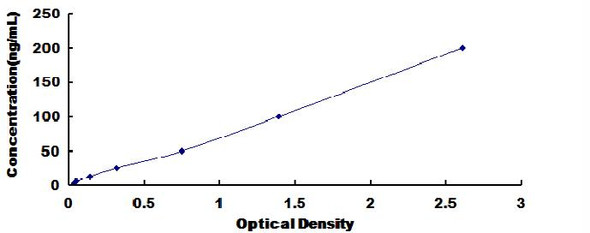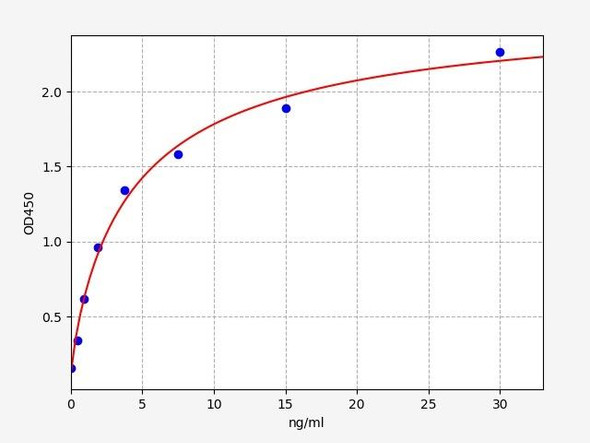Human Immunology ELISA Kits 1
Human FG alpha (Fibrinogen Alpha) CLIA Kit (HUES01126)
- SKU:
- HUES01126
- Product Type:
- ELISA Kit
- ELISA Type:
- CLIA Kit
- Size:
- 96 Assays
- Sensitivity:
- 0.94ng/mL
- Range:
- 1.56-100ng/mL
- ELISA Type:
- Sandwich
- Reactivity:
- Human
- Sample Type:
- Serum, plasma and other biological fluids
- Research Area:
- Immunology
Description
| Assay type: | Sandwich |
| Format: | 96T |
| Assay time: | 4.5h |
| Reactivity: | Human |
| Detection method: | Chemiluminescence |
| Detection range: | 1.56-100 ng/mL |
| Sensitivity: | 0.94 ng/mL |
| Sample volume: | 100µL |
| Sample type: | Serum, plasma and other biological fluids |
| Repeatability: | CV < 15% |
| Specificity: | This kit recognizes Human FG alpha in samples. No significant cross-reactivity or interference between Human FG alpha and analogues was observed. |
This kit uses Sandwich-CLIA as the method. The micro CLIA plate provided in this kit has been pre-coated with an antibody specific to Human FG alpha. Standards or samples are added to the appropriate micro CLIA plate wells and combined with the specific antibody. Then a biotinylated detection antibody specific for Human FG alpha and Avidin-Horseradish Peroxidase (HRP) conjugate are added to each micro plate well successively and incubated. Free components are washed away. The substrate solution is added to each well. Only those wells that contain Human FG alpha, biotinylated detection antibody and Avidin-HRP conjugate will appear fluorescence. The Relative light unit (RLU) value is measured spectrophotometrically by the Chemiluminescence immunoassay analyzer. The RLU value is positively associated with the concentration of Human FG alpha. The concentration of Human FG alpha in the samples can be calculated by comparing the RLU of the samples to the standard curve.
| UniProt Protein Function: | FGA: Fibrinogen has a double Function: yielding monomers that polymerize into fibrin and acting as a cofactor in platelet aggregation. Defects in FGA are a cause of congenital afibrinogenemia (CAFBN). This is a rare autosomal recessive disorder characterized by bleeding that varies from mild to severe and by complete absence or extremely low levels of plasma and platelet fibrinogen. The majority of cases of afibrinogenemia are due to truncating mutations. Variations in position Arg-35 (the site of cleavage of fibrinopeptide a by thrombin) leads to alpha- dysfibrinogenemias. Defects in FGA are a cause of amyloidosis type 8 (AMYL8); also known as systemic non-neuropathic amyloidosis or Ostertag-type amyloidosis. AMYL8 is a hereditary generalized amyloidosis due to deposition of apolipoprotein A1, fibrinogen and lysozyme amyloids. Viscera are particularly affected. There is no involvement of the nervous system. Clinical features include renal amyloidosis resulting in nephrotic syndrome, arterial hypertension, hepatosplenomegaly, cholestasis, petechial skin rash. 2 isoforms of the human protein are produced by alternative splicing. |
| UniProt Protein Details: | Protein type:Secreted; Secreted, signal peptide Chromosomal Location of Human Ortholog: 4q28 Cellular Component: extracellular space; cell surface; fibrinogen complex; plasma membrane; extracellular region; cell cortex; vesicle; external side of plasma membrane Molecular Function:protein binding, bridging; protein binding; cell adhesion molecule binding; structural molecule activity; receptor binding Biological Process: protein polymerization; platelet activation; extracellular matrix organization and biogenesis; positive regulation of heterotypic cell-cell adhesion; cell-matrix adhesion; signal transduction; cellular protein complex assembly; platelet degranulation; positive regulation of protein secretion; positive regulation of vasoconstriction; innate immune response; blood coagulation; response to calcium ion; positive regulation of exocytosis Disease: Amyloidosis, Familial Visceral; Afibrinogenemia, Congenital; Dysfibrinogenemia, Congenital |
| NCBI Summary: | The protein encoded by this gene is the alpha component of fibrinogen, a blood-borne glycoprotein comprised of three pairs of nonidentical polypeptide chains. Following vascular injury, fibrinogen is cleaved by thrombin to form fibrin which is the most abundant component of blood clots. In addition, various cleavage products of fibrinogen and fibrin regulate cell adhesion and spreading, display vasoconstrictor and chemotactic activities, and are mitogens for several cell types. Mutations in this gene lead to several disorders, including dysfibrinogenemia, hypofibrinogenemia, afibrinogenemia and renal amyloidosis. Alternative splicing results in two isoforms which vary in the carboxy-terminus. [provided by RefSeq, Jul 2008] |
| UniProt Code: | P02671 |
| NCBI GenInfo Identifier: | 1706799 |
| NCBI Gene ID: | 2243 |
| NCBI Accession: | P02671. 2 |
| UniProt Secondary Accession: | P02671,Q4QQH7, Q9BX62, Q9UCH2, A8K3E4, D3DP14, D3DP15 |
| UniProt Related Accession: | P02671 |
| Molecular Weight: | 69,757 Da |
| NCBI Full Name: | Fibrinogen alpha chain |
| NCBI Synonym Full Names: | fibrinogen alpha chain |
| NCBI Official Symbol: | FGA |
| NCBI Official Synonym Symbols: | Fib2 |
| NCBI Protein Information: | fibrinogen alpha chain; fibrinogen, A alpha polypeptide |
| UniProt Protein Name: | Fibrinogen alpha chain |
| Protein Family: | Fibrinogen |
| UniProt Gene Name: | FGA |
| UniProt Entry Name: | FIBA_HUMAN |
As the RLU values of the standard curve may vary according to the conditions of the actual assay performance (e. g. operator, pipetting technique, washing technique or temperature effects), the operator should establish a standard curve for each test. Typical standard curve and data is provided below for reference only.
| Concentration (ng/mL) | RLU | Average | Corrected |
| 100 | 37184 37924 | 37554 | 37521 |
| 50 | 14768 17714 | 16241 | 16208 |
| 25 | 8104 6980 | 7542 | 7509 |
| 12.5 | 3388 3976 | 3682 | 3649 |
| 6.25 | 1904 1846 | 1875 | 1842 |
| 3.13 | 1020 982 | 1001 | 968 |
| 1.56 | 566 578 | 572 | 539 |
| 0 | 32 34 | 33 | -- |
Precision
Intra-assay Precision (Precision within an assay): 3 samples with low, mid range and high level Human FG alpha were tested 20 times on one plate, respectively.
Inter-assay Precision (Precision between assays): 3 samples with low, mid range and high level Human FG alpha were tested on 3 different plates, 20 replicates in each plate.
| Intra-assay Precision | Inter-assay Precision | |||||
| Sample | 1 | 2 | 3 | 1 | 2 | 3 |
| n | 20 | 20 | 20 | 20 | 20 | 20 |
| Mean (ng/mL) | 5.49 | 11.14 | 43.66 | 5.94 | 11.36 | 47.43 |
| Standard deviation | 0.47 | 1.31 | 3.97 | 0.73 | 1.24 | 3.25 |
| C V (%) | 8.56 | 11.76 | 9.09 | 12.29 | 10.92 | 6.85 |
Recovery
The recovery of Human FG alpha spiked at three different levels in samples throughout the range of the assay was evaluated in various matrices.
| Sample Type | Range (%) | Average Recovery (%) |
| Serum (n=5) | 87-103 | 94 |
| EDTA plasma (n=5) | 92-104 | 97 |
| Cell culture media (n=5) | 94-109 | 99 |
Linearity
Samples were spiked with high concentrations of Human FG alpha and diluted with Reference Standard & Sample Diluent to produce samples with values within the range of the assay.
| Serum (n=5) | EDTA plasma (n=5) | Cell culture media (n=5) | ||
| 1:2 | Range (%) | 95-108 | 85-101 | 102-114 |
| Average (%) | 102 | 92 | 107 | |
| 1:4 | Range (%) | 97-112 | 101-115 | 94-107 |
| Average (%) | 104 | 109 | 101 | |
| 1:8 | Range (%) | 91-101 | 93-105 | 88-104 |
| Average (%) | 96 | 99 | 95 | |
| 1:16 | Range (%) | 98-114 | 91-106 | 92-106 |
| Average (%) | 106 | 98 | 97 |
An unopened kit can be stored at 4°C for 1 month. If the kit is not used within 1 month, store the items separately according to the following conditions once the kit is received.
| Item | Specifications | Storage |
| Micro CLIA Plate(Dismountable) | 8 wells ×12 strips | -20°C, 6 months |
| Reference Standard | 2 vials | |
| Concentrated Biotinylated Detection Ab (100×) | 1 vial, 120 µL | |
| Concentrated HRP Conjugate (100×) | 1 vial, 120 µL | -20°C(shading light), 6 months |
| Reference Standard & Sample Diluent | 1 vial, 20 mL | 4°C, 6 months |
| Biotinylated Detection Ab Diluent | 1 vial, 14 mL | |
| HRP Conjugate Diluent | 1 vial, 14 mL | |
| Concentrated Wash Buffer (25×) | 1 vial, 30 mL | |
| Substrate Reagent A | 1 vial, 5 mL | 4°C (shading light) |
| Substrate Reagent B | 1 vial, 5 mL | 4°C (shading light) |
| Plate Sealer | 5 pieces | |
| Product Description | 1 copy | |
| Certificate of Analysis | 1 copy |
- Set standard, test sample and control (zero) wells on the pre-coated plate and record theirpositions. It is recommended to measure each standard and sample in duplicate. Note: addall solutions to the bottom of the plate wells while avoiding contact with the well walls. Ensuresolutions do not foam when adding to the wells.
- Aliquot 100 µL of standard solutions into the standard wells.
- Add 100 µL of Sample / Standard dilution buffer into the control (zero) well.
- Add 100 µL of properly diluted sample (serum, plasma, tissue homogenates and otherbiological fluids. ) into test sample wells.
- Cover the plate with the sealer provided in the kit and incubate for 90 min at 37 °C.
- Aspirate the liquid from each well, do not wash. Immediately add 100 µL of BiotinylatedDetection Ab working solution to each well. Cover the plate with a plate seal and gently mix. Incubate for 1 hour at 37 °C.
- Aspirate or decant the solution from the plate and add 350 µL of wash buffer to each welland incubate for 1-2 minutes at room temperature. Aspirate the solution from each well andclap the plate on absorbent filter paper to dry. Repeat this process 3 times. Note: a microplatewasher can be used in this step and other wash steps.
- Add 100 µL of HRP Conjugate working solution to each well. Cover with a plate seal andincubate for 30 min at 37 °C.
- Aspirate or decant the solution from each well. Repeat the wash process for five times asconducted in step 7.
- Add 100 µL of Substrate mixture solution to each well. Cover with a new plate seal andincubate for no more than 5 min at 37 °C. Protect the plate from light.
- Determine the RLU value of each well immediately.






